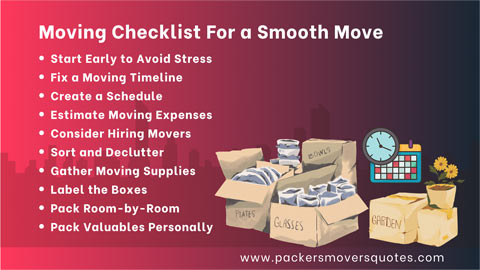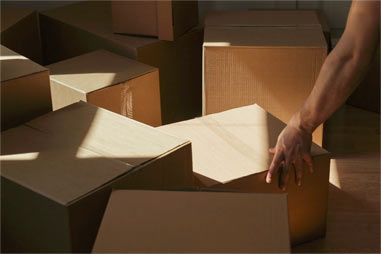Moving, whether across town or to an entirely new city, marks a significant chapter in our lives. It’s a thrilling transition, filled with the promise of new beginnings, but let’s face it – the process itself can be a daunting maze of decisions, logistics, and, of course, packing tape.
We understand that executing a successful move involves careful planning and attention to detail. That’s why we’ve crafted this comprehensive guide – a roadmap to help you navigate the complexities of relocation with ease. Welcome to “The Ultimate Moving Checklist,” your go-to resource for turning the chaos of moving into a well-choreographed symphony.
This isn’t just a checklist; it’s your personalized guide to not only survive but thrive during the moving process. From the initial spark of deciding to move to settling into your new space, we’ve got you covered every step of the way. So, let’s embark on this journey together, turning what could be a stressful experience into a seamless adventure.
Ready to transform your move from a daunting task to a well-executed plan? Let’s dive into the details of creating a move that’s not just a change of address but a smooth transition into your next exciting chapter.
Pre-Move Preparation

Define Your Moving Timeline
One of the first steps in preparing for a move is to set a clear moving date. Consider factors such as lease agreements, closing dates, or job start dates to determine the most suitable time for your move. Once you’ve pinpointed the date, work backwards to create a timeline that allocates specific tasks to different weeks or days leading up to the move.
Create a Schedule Leading Up to the Move Day
Break down the weeks or days before your move into manageable tasks. This could include activities like notifying utility companies, packing specific rooms, or arranging for childcare or pet care on moving day. A well-structured schedule helps distribute the workload evenly and reduces the likelihood of feeling overwhelmed as the moving day approaches.
Estimate Your Moving Expenses
Moving comes with its share of expenses, and estimating these costs upfront can help you plan your budget more effectively. Consider factors such as moving services, packing materials, transportation, and potential storage fees. Having a rough estimate allows you to allocate funds appropriately and avoid any financial surprises.
Consider Hiring Professional Movers and Gather Quotes
While a DIY move is an option, hiring professional movers can save you time and effort. Research reputable moving companies and gather quotes well in advance. This step allows you to compare services, prices, and customer reviews to make an informed decision. Booking movers early ensures availability on your chosen moving date.
Sort and Declutter
Before you start packing, take the time to go through each room and assess your belongings. Consider what items are essential and what you can part with. This is a great opportunity to declutter your home and minimize the number of items you’ll need to pack and transport.
Start Early to Avoid Last-Minute Stress
Procrastination is a common pitfall during the moving process. Starting the sorting and decluttering process early not only reduces stress but also allows you to donate or sell items you no longer need. Set aside dedicated time each week to tackle specific rooms or categories, ensuring a more organized and efficient moving experience.
By diligently following these pre-move preparation steps, you set the foundation for a well-organized and stress-free moving process.
Gather Moving Supplies
Purchase or Collect Sturdy Moving Boxes

Acquiring sturdy moving boxes is a fundamental step in ensuring the safety of your belongings during transit. Purchase new boxes from a moving supply store or consider collecting gently-used boxes from local businesses or friends who have recently moved. Make sure the boxes are in good condition and free from any structural damage.
Gather Packing Tape, Bubble Wrap, Packing Paper, and Other Necessary Materials
In addition to boxes, having the right packing materials is crucial for safeguarding your possessions. Gather packing tape to secure boxes, bubble wrap to cushion fragile items, and packing paper to wrap delicate objects. Consider other materials such as packing peanuts, foam sheets, or furniture blankets, depending on the nature of your belongings.
Label the Boxes Based on Rooms or Categories
A well-thought-out labelling system streamlines the unpacking process and helps movers or helpers know where each box belongs. Assign a specific label or color code for each room or category (e.g., kitchen, bedroom, electronics). Clearly mark the labels on the top and sides of each box. This simple step makes it easier to organize and prioritize boxes during unloading.
Label Fragile Items Clearly
For boxes containing fragile items, go the extra mile in labeling. Use bright and easily recognizable labels, and write “Fragile” in large, bold letters. This ensures that both you and your movers handle these boxes with extra care. Consider marking boxes with delicate items with arrows indicating the upright position to prevent accidental mishandling.
Having a comprehensive labeling system not only facilitates a smoother unpacking process but also minimizes the risk of damage to fragile items.
By paying attention to these details during the gathering of moving supplies, you’re laying the groundwork for a well-organized packing and unpacking experience, enhancing the overall efficiency of your move.
Notify Relevant Parties
Change of Address
Initiating a change of address with the post office is a crucial step to ensure that your mail is redirected to your new location. You can typically do this online or visit your local post office. Provide the necessary information, including your old and new addresses, and specify the start date for the change of address. This helps prevent important mail from getting lost during the transition.
Inform Utility Companies, Subscription Services, and Relevant Institutions
To avoid service interruptions, inform utility companies (water, gas, electricity, internet, etc.) about your upcoming move. Schedule the disconnection of services at your old address and arrange for the setup of services at your new residence. Additionally, update your address with subscription services, such as magazines, newspapers, or streaming platforms. Don’t forget to notify relevant institutions like banks, credit card companies, and insurance providers of your change of address.
Medical Records and Prescriptions
If you’re moving to a new city or state, it’s essential to transfer your medical records to your new healthcare provider. Contact your current healthcare professionals and request copies of your medical records. Provide these records to your new healthcare provider to ensure continuity of care. This step is particularly important if you have ongoing health conditions or require regular medical attention.
Before the move, check your prescription medications and ensure you have an ample supply to last through the transition period. Contact your prescribing physician to discuss your move and arrange for any necessary prescriptions. Consider transferring your prescriptions to a pharmacy near your new location. Having a sufficient medication supply helps you avoid disruptions in your healthcare routine during the moving process.
By proactively addressing these notification tasks, you’re not only safeguarding the continuity of essential services but also ensuring a smoother transition to your new home. This step is crucial for maintaining a sense of normalcy in your daily life during the moving period.
Packing Strategy
Room-by-Room Packing
Approaching the packing process room by room is a systematic and efficient strategy. Begin by focusing on one room at a time, starting with those that are less frequently used. This method helps maintain organization and reduces the chaos of having items from different rooms mixed together. Use this opportunity to declutter and decide what items are essential and what can be donated or discarded.
Keep Essential Items Easily Accessible
As you pack, set aside a box or bag for essential items that you’ll need immediately upon arriving at your new home. This could include toiletries, a change of clothes, important documents, and any necessary medications. Label this box clearly and keep it with you during the move, ensuring that you have quick access to the essentials without having to unpack everything on the first day.
Pack Valuables and Important Documents Securely
Gather all important documents, such as passports, birth certificates, insurance policies, and legal documents, and pack them securely in a designated box or folder. Consider using a waterproof and fireproof container for added protection. Label this box clearly as “Important Documents” and personally transport it to ensure it doesn’t get misplaced during the move.
Transport Valuables, Such as Jewelry, Separately or Personally
For valuable items like jewelry, family heirlooms, or sentimental possessions, take extra precautions. Pack these items separately in a small, secure box. It’s advisable to transport such valuables personally rather than including them with the rest of your belongings. This minimizes the risk of loss or damage and allows you to keep a close eye on items of high personal or monetary value.
Having a clear and organized packing strategy not only simplifies the moving process but also makes the unpacking phase more manageable. By focusing on one room at a time and prioritizing essential items, you can maintain a sense of order and control throughout the move. Additionally, safeguarding valuables and important documents ensures peace of mind during this transitional period.
Moving Day Essentials
Pack a Box with Essentials for the First Day in Your New Home
An “Essentials Box” is a lifesaver for the first day in your new home. This box should contain everything you might need immediately without having to rummage through numerous boxes. Here’s what to include:
Toiletries: Pack a set of basic toiletries, including toothbrushes, toothpaste, soap, shampoo, and any other personal hygiene items your family may need.
A Change of Clothes: Include a change of clothes for each family member. Moving can be messy, and having fresh clothes readily available can make the first day more comfortable.
Important Documents: Keep a folder with essential documents such as identification, medical records, lease or mortgage documents, and any paperwork related to the move.
Chargers: Bring chargers for your electronic devices, ensuring you can stay connected during and after the move.
Snacks and Water: Include some non-perishable snacks and water to keep everyone energized throughout the day.
Label the Essentials Box Clearly
Label the box prominently as “Essentials” and make sure it’s easily accessible during the move. Consider placing it in your personal vehicle rather than the moving truck to ensure immediate access upon arrival.
Confirm the Details with Your Chosen Moving Company
In the days leading up to the move, reach out to your chosen moving company to confirm all the details. This includes verifying the moving date, the time the movers are expected to arrive, and any specific requirements or instructions you’ve communicated.
Provide Your Contact Information for the Day of the Move
Ensure the moving company has your updated contact information, including your mobile phone number. This allows them to reach you if there are any unforeseen changes or if they need to coordinate logistics on the day of the move.
By having a dedicated Essentials Box and confirming the moving details, you set the stage for a smoother transition into your new home. This proactive approach ensures that you have the essentials on hand and helps prevent potential hiccups on moving day.
Post-Move Tasks
Unpack Strategically, Starting with Essential Items
Once you’ve arrived at your new home, it’s time to tackle the unpacking process. Start by strategically unpacking essential items that you packed separately in your Essentials Box. This includes toiletries, a change of clothes, important documents, and any other items crucial for the first day and night in your new home. Having these essentials readily available alleviates the initial stress of unpacking everything at once.
Set Up One Room at a Time
Instead of trying to unpack the entire house in one go, take a systematic approach by setting up one room at a time. Begin with commonly used spaces like the bedroom, kitchen, or living room. As you complete each room, it creates functional and organized spaces amid the unpacked chaos. This approach allows you to gradually settle into your new home without feeling overwhelmed.
Ensure All Utilities Are Set Up at Your New Home
To guarantee a smooth transition into your new home, ensure that all necessary utilities are set up and functioning. Contact local utility providers to activate services such as water, gas, electricity, internet, and cable. Confirm the start date for these services to coincide with your move-in date. This step helps you avoid any inconvenience and ensures that your new home is ready for occupancy.
Double-Check That Appliances Are Working
Before diving into the full unpacking process, double-check that major appliances, such as the refrigerator, stove, dishwasher, and heating or cooling systems, are in working order. If you’ve moved with these appliances, make sure they are properly connected and functioning. Identifying and addressing any issues early on can save you time and hassle in the long run.
By following these post-move tasks, you streamline the process of settling into your new home. Unpacking strategically and setting up one room at a time allows you to gradually transform your new space into a comfortable and functional environment. Ensuring that utilities are in place and appliances are working contributes to a seamless transition and a positive start in your new home.
Settling In
Explore Your New Neighborhood
Familiarize Yourself with Local Services, Shops, and Emergency Facilities
Take some time to explore your new neighbourhood and get acquainted with the local services and amenities. Identify the nearest grocery stores, pharmacies, hospitals or clinics, schools, and other essential services. Knowing the layout of your new area helps you feel more at ease and ensures that you can quickly access what you need.
Meet Your Neighbors and Build a Sense of Community
Building connections in your new community can significantly enhance your sense of belonging. Introduce yourself to your neighbours, attend community events, or join local groups or clubs. Establishing positive relationships with those around you creates a supportive network and fosters a sense of community. This can be particularly valuable in times of need or emergencies.
Update Address for Legal and Financial Documents
Ensure a seamless transition by promptly updating your address with legal and financial institutions. This includes notifying government offices, the Department of Motor Vehicles (DMV), and any relevant licensing or registration authorities of your change of address. This step is crucial for maintaining compliance with legal requirements in your new jurisdiction.
Confirm the Change with Your Bank and Other Relevant Entities
Contact your bank, credit card companies, insurance providers, and any other relevant financial entities to inform them of your new address. This helps prevent any disruptions in communication, ensures you receive important documents and allows for a smooth continuation of financial transactions.
By actively engaging in the settling-in process, you not only make your new environment feel more like home but also establish a foundation for a positive living experience. Familiarizing yourself with local resources and services and updating your address with legal and financial institutions contribute to a seamless integration into your new community.
Conclusion: Smooth Transitions Begin with Smart Planning
Congratulations on reaching the end of our Ultimate Moving Checklist! Moving is a journey filled with both challenges and exciting new beginnings, and with the right preparation, it can be a smooth and positive experience.
As we recap the key points of this checklist – from defining your moving timeline to settling into your new community – remember that each step plays a vital role in ensuring a seamless transition. Room-by-room packing, strategic unpacking, and staying organized throughout the process contribute to a stress-free move.
We’re eager to hear about your moving experiences and the strategies that worked best for you. The comment section below is your space to share tips, stories, and insights. Your unique perspective might just be the advice someone else needs for their upcoming move.
Thank you for entrusting us with a part of your moving journey. Wishing you a smooth transition to your new home and the beginning of a new and exciting chapter in your life!
Safe travels and happy settling!
Packers Movers Quotes Team
